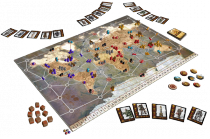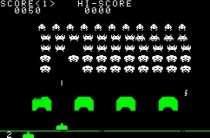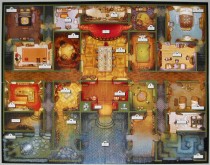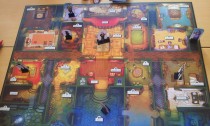Monthly Archives: September 2014

Board Game Analysis: Kill Dr. Lucky
Back again, after a minor hiatus! This time, an assignment was given to pick a board game, play it in a group, and analyze it, determining the core game system (including objects, properties, behaviours and relationships), the good and bad sides of the game, and the most interesting system.
The game we picked was Kill Doctor Lucky. It is a turn-based game for between 3 and 7 players ages 10 and above (according to the box), which works sort […]

Board Game Analysis: Kill Dr. Lucky
Back again, after a minor hiatus! This time, an assignment was given to pick a board game, play it in a group, and analyze it, determining the core game system (including objects, properties, behaviours and relationships), the good and bad sides of the game, and the most interesting system.
The game we picked was Kill Doctor Lucky. It is a turn-based game for between 3 and 7 players ages 10 and above (according to the box), which works sort […]
Board Game Analysis 1 – Drakborgen Legenden
Introduction
We were tasked with playing and analyzing a board game of our choosing as a team and then individually write an analysis of our experience with that game. The main goal was to get an understanding of the core systems and how they affect they game.
To gain as much understanding as possible of the game and its different play styles, we decided to play the game on three separate occasions. The game we chose was Drakborgen Legenden.
Drakborgen Legenden
Drakborgen Legenden, released […]
Board Game Analysis 1 – Drakborgen Legenden
Introduction
We were tasked with playing and analyzing a board game of our choosing as a team and then individually write an analysis of our experience with that game. The main goal was to get an understanding of the core systems and how they affect they game.
To gain as much understanding as possible of the game and its different play styles, we decided to play the game on three separate occasions. The game we chose was Drakborgen Legenden.
Drakborgen Legenden
Drakborgen Legenden, released […]
Board game analysis – Dust
Introduction
During the course Advanced game design we were split into groups to play and analyse a board game. Our group chose the strategy game Dust.
Game description
Dust is a board strategy game, for two to six players, similar to RISK where your objective is to hold key locations on the game board which give victory points and the first to a set amount of victory points win. To do this the players have different cards and units to their disposal. The […]
Board game analysis – Dust
Introduction
During the course Advanced game design we were split into groups to play and analyse a board game. Our group chose the strategy game Dust.
Game description
Dust is a board strategy game, for two to six players, similar to RISK where your objective is to hold key locations on the game board which give victory points and the first to a set amount of victory points win. To do this the players have different cards and units to their disposal. The […]
Week 2, MDA-framework.
So week number two has passed. This week we were thought of the MDA framework. MDA stands for Mechanics-Dynamics-Aesthetics.
Mechanics is in short terms how a game function and what the played can do within the game.
Dynamics is how the game is played by the player.
Aesthetics is how the player will or should feel when playing the game.
Also during this week we made a sissyfight revamp, which we call Master Ai.
It is pretty much a quiz game, which Adam(our teacher) did […]
Week 2, MDA-framework.
So week number two has passed. This week we were thought of the MDA framework. MDA stands for Mechanics-Dynamics-Aesthetics.
Mechanics is in short terms how a game function and what the played can do within the game.
Dynamics is how the game is played by the player.
Aesthetics is how the player will or should feel when playing the game.
Also during this week we made a sissyfight revamp, which we call Master Ai.
It is pretty much a quiz game, which Adam(our teacher) did […]

Board Game Analysis – Citadels + The Dark City Expansion
Introduction
We were tasked to analyze a Board Game for a course; Advanced Game Design. We had earlier been divided in to groups of around 6 people each. We got to choose what game we wanted to play ourselves, wither from a big selection of games that the school owned or we could choose to play a game we owned ourselves. We selected a game called Citadels together with an expansion for the game called The Dark City.
Citadels + The Dark […]

Board Game Analysis – Citadels + The Dark City Expansion
Introduction
We were tasked to analyze a Board Game for a course; Advanced Game Design. We had earlier been divided in to groups of around 6 people each. We got to choose what game we wanted to play ourselves, wither from a big selection of games that the school owned or we could choose to play a game we owned ourselves. We selected a game called Citadels together with an expansion for the game called The Dark City.
Citadels + The Dark […]

Analysing a Boardgame #1
The second year of game design has started, and with it a new task to analyze board games.
The task consists of first playing the game and then deciding the objectively worst and best sides of the game. After that we are to decide the core game system, meaning the system that the entire game revolves around, and then defining the objects, functions and the properties, behavior and relationships that is this game.
And then we choose the subjectively most interesting system […]

Analysing a Boardgame #1
The second year of game design has started, and with it a new task to analyze board games.
The task consists of first playing the game and then deciding the objectively worst and best sides of the game. After that we are to decide the core game system, meaning the system that the entire game revolves around, and then defining the objects, functions and the properties, behavior and relationships that is this game.
And then we choose the subjectively most interesting system […]

An Introduction
Hello! I am Marcus, a GAME student over att Uppsala University currently studying Game Design and Game Analysis with a secondary course in Graphics. This blog will showcase the work I have done each week and I will post updates hopefully every friday.
Last week’s assignment
Last week we had the assignment to analyze the good old game Space Invaders by looking at the objects of the game, the properties and behavior of those objects as well as how they relate to […]

An Introduction
Hello! I am Marcus, a GAME student over att Uppsala University currently studying Game Design and Game Analysis with a secondary course in Graphics. This blog will showcase the work I have done each week and I will post updates hopefully every friday.
Last week’s assignment
Last week we had the assignment to analyze the good old game Space Invaders by looking at the objects of the game, the properties and behavior of those objects as well as how they relate to […]

Kill Doctor Lucky
Hello reader(s). I’m back from a long summer holiday! First blog post this term is going to be an analysis of Kill Doctor Lucky, a board game.
The best parts of Kill Doctor Lucky:
My Favorite part of Kill Doctor Lucky was the line of sight aspect to the game, which I thought was pretty unique for a board game. I had never earlier heard of a board game with line of sight in it. Line of sight is not only one […]

Kill Doctor Lucky
Hello reader(s). I’m back from a long summer holiday! First blog post this term is going to be an analysis of Kill Doctor Lucky, a board game.
The best parts of Kill Doctor Lucky:
My Favorite part of Kill Doctor Lucky was the line of sight aspect to the game, which I thought was pretty unique for a board game. I had never earlier heard of a board game with line of sight in it. Line of sight is not only one […]
Week 2. MDA.
The second week on Gotland has been inspiring in a whole new array of ways. With the introduction of the MDA -framework came a whole new way to look at games as both a designer and a consumer. Why do I enjoy this game, what does it offer me as a player that inspire this type of emotion in me? How can I use this emotional response as a designer?
If I want to my players to enjoy fellowship fun in […]
Week 2. MDA.
The second week on Gotland has been inspiring in a whole new array of ways. With the introduction of the MDA -framework came a whole new way to look at games as both a designer and a consumer. Why do I enjoy this game, what does it offer me as a player that inspire this type of emotion in me? How can I use this emotional response as a designer?
If I want to my players to enjoy fellowship fun in […]
Space Shooter idea #1
So some kind of generic Gradius 3 game/asteroid.
Except with the “unique” mechanics: “Thrust” – accelerate forward to mouse location. If enemy is hit during the way they gain the players momentum+x and bouncy around like you would play pool. If two enemies collide something will happen ofcourse.
Second mechanic: “Portal” creates a portal in a solid map object making it passable for the ship and other debris for a duration of time. can also be used to travel from the bottom […]
Space Shooter idea #1
So some kind of generic Gradius 3 game/asteroid.
Except with the “unique” mechanics: “Thrust” – accelerate forward to mouse location. If enemy is hit during the way they gain the players momentum+x and bouncy around like you would play pool. If two enemies collide something will happen ofcourse.
Second mechanic: “Portal” creates a portal in a solid map object making it passable for the ship and other debris for a duration of time. can also be used to travel from the bottom […]

Analyzing: Kill Doctor Lucky
Introduction:
We in the Game Design program got an assignment, to analyze a board game that we chose in a group. The game my group chose is a game called Kill Doctor Lucky.
The game:
So, the game is about killing a man named doctor Lucky. You play as one of 3-7 people that has been invited to his mansion a stormy midsummers eve. The house is quite big, sporting 24 named rooms, 6 hallways and […]

Analyzing: Kill Doctor Lucky
Introduction:
We in the Game Design program got an assignment, to analyze a board game that we chose in a group. The game my group chose is a game called Kill Doctor Lucky.
The game:
So, the game is about killing a man named doctor Lucky. You play as one of 3-7 people that has been invited to his mansion a stormy midsummers eve. The house is quite big, sporting 24 named rooms, 6 hallways and […]
Game System Analysis 1 – DUST
Intro
The first week of our current game design course, Advanced Game Design, we were tasked with playing a board game of our choice and, once played a minimum of 3 sessions, analyse it and figure out it’s underlying game system. We chose, without reading anything about it prior, a game called DUST.
DUST is a competitive strategy game played on a map of the earth. The map has connected, circled land or sea areas scattered over it. Some of these areas […]
Game System Analysis 1 – DUST
Intro
The first week of our current game design course, Advanced Game Design, we were tasked with playing a board game of our choice and, once played a minimum of 3 sessions, analyse it and figure out it’s underlying game system. We chose, without reading anything about it prior, a game called DUST.
DUST is a competitive strategy game played on a map of the earth. The map has connected, circled land or sea areas scattered over it. Some of these areas […]